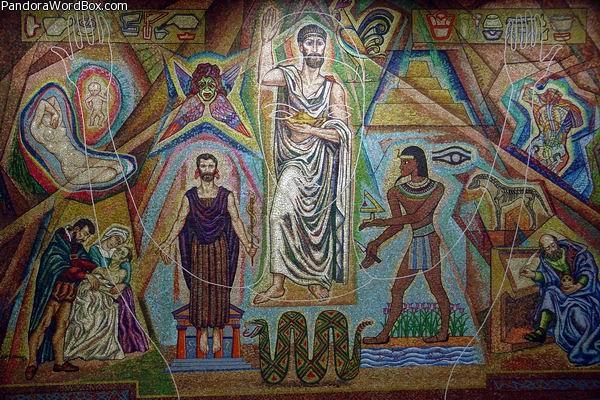|
× UKRAINIAN CHILDREN WITH DISABILITIES HAVE SPECIAL NEEDS |
HISTORY OF MEDICINE

"History of Medicine Mosaic" (see details A | B | C | D) (see related A | B), 1960 A. Conrad Albrizio ( 1894 - 1973) Lobby University Hospital of the University of South Alabama, Mobile, Alabama, USA
This artistic and beautiful mosaic presents a carefully researched graphic representation of symbols of the history of medicine. This work also lends itself to an elaboration on ideas and notions inherent in words.
The central figure is Hippocrates, the father of Medicine, holding a lamp as an emblem of enlightenment, thus truth. This emblem points to Apollo, who stood for Healing and Harmony (Medicine and Music). Apollo had only one son whom he rescued from the dying body of the mother by performing the first "Caesarean" section and named his infant son Aesculapius, who like his mother was a mortal until deified later.
The two central figures are Aesculapius on the left and Imhotep (holding a scalpel) on the right of Hippocrates.
Apollo entrusted the wise centaur Chiron to nurture Asculapius and teach him practical or "handy" (surgical) medicine (cheiro - chiropractic treatments). Apollo also endowed Aesculapius with "oracular" or powers of vaticination (as in Vatican, implying the power of prophesy or prognostication). After his death, Aesculapius was elevated to the status of a demi-god (saint) and the temples erected in his memory became sites hospitable to the ailing seeking bed rest and sleep. With time the temples became hospices and later hospitals. The link of mercy, charity, cures, and Medicine is implicit in the name "Charite", a series of hospitals and medical academic institutions found in many world cities such as in Paris, Berlin, and New Orleans, among other.
Imhotep preceded Aesculapius and also was a mortal deified by the Egyptians for his caring for the sick and knowledge of nature and science (note the plumb and other implements - he constructed the first and oldest surviving pyramid). Probably the travelling Greeks adopted and adapted the emblematic Imhotep heroic story and crated their version personified by Aesulapius. Imhotep (Immutef or Imuthes), a mortal like Aesculapius was a polymath skilled in Medicine and the first known architect by its name - he built the Step Pyramid some 5000 years ago. Centuries after his death, Imhotep was still remembered and deified by the Egyptian people - in this mosaic his canonical representation akin to many ancient hieroglyph show him holding a plumb and scalpel and an owl (emblems of knowledge), which when combined denote the aplomb, experience, and wisdom expected from surgeons. Note that the owl, much later, became the emblem of wisdom and became associated with Athena and Minerva (a Roman deity of Medicine and Wisdom).
The Imhotep or "step" pyramid stands today and is also shown on every U.S. dollar bill.
Between Aesculapius and Imhotep rises Hippocrates who a raised hand indicative of taking an oath - the first profession, Medicine, to adhere to an ethics code. The Hippocratic Oath remains the central guideline for physicians to adhere to - to profess a profession in contrast to engage in "business".
Above Aesculapius is a tetra-winged mask, akin to "tetra-winged" angels often depicted in murals of Eastern Orthodox churches - they represent "Oracles" or the voice of divinities.
Also worth noting is the owl, an emblem of wisdom associated with Imhotep and later with Athena, the deity of Wisdom in Greece and Minerva, the deity of Wisdom and Medicine in Rome.
Also of interest is the "eye" proximal to the head of Imhotep, an emblem of "pro-vidence", that is the ability to see the future (prognosis). This power of "vaticinate" (note "Vatican" granting divine forgiveness) - pro-video or providence is also represented on U.S. dollar bills above the Imhotep pyramid.
Furthest to the left of Hippocrates is Galen examining a human skull. As the personal physician of Emperor Marcus Aurelius, Galen impacted Medicine in every corner of the civilized world. His views and innovations stood until the Renaissance.
Distant to the right of Hippocrates is Vesalius, a 16th. century Flemish anatomist and physician who studied in Bologna and Padua and injected Galenic and Arab advances into European Universities. From Salerno, Naples, Padua, Bologna, Cordoba, Paris, Oxford, Krakow, Prague, among others, new medical knowledge spread across Europe.
Above Imhotep are shown emblems of the drug and pharmaceutical industries. Below them is a woman and her matrix containing a child-to-be, she seems dazed perhaps because she is aware of the many factors, including medications, that may destroy or harm the unborn. Perhaps these icons suggest that the "price of progress" is the exposure of a growing number of unborn beings to a growing number of toxins and teratogens, from which may emerge a scenario reminiscent of Saturn devouring his own children.
20201029 ww
|








